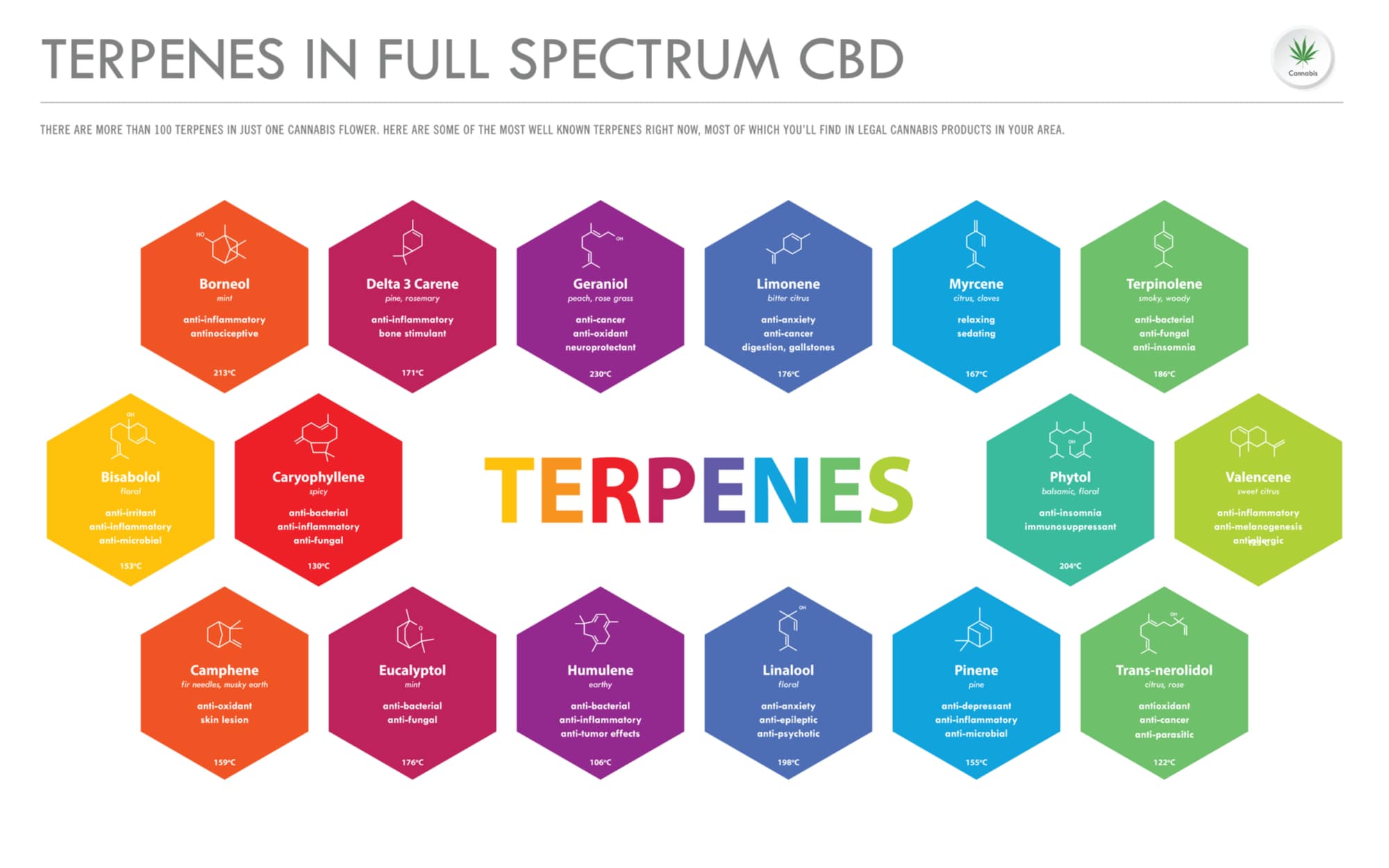The world of CBD is only getting more complex. Today consumers can choose from endless CBD tincture variations . . . smorgasbords of CBD edibles . . . heck, there’s even a CBD- infused mattress out there in retail-land somewhere (really).
But, thankfully, there’s one facet of the CBD industry that’s managed to stay quite simple. Most CBD products are still made with one of two different types of CBD, namely, CBD isolate and full spectrum CBD. These terms describe the cannabinoid content you’ll find in your product.
In this comprehensive guide we’ll be diving deep into both of them—what they are, how they’re made, and what makes them tick. So sit down with your beverage of choice (CBD- infused coffee, perhaps?) and feel free to tag along with us . . . happy reading!
* If you’re short on time, no worries. Here’s an equally short outline of what you can expect to see . . . jump around as necessary. There are also some pretty science-y sections in this article. If that’s not what you’re looking for, feel free to skip them!
The State of the CBD Industry
Within hemp’s pharmacology lies another mystery: the entourage effect, a colorful term used to describe the beneficial synergistic effect that appears to occur when multiple botanical compounds are allowed to work together rather than in isolation. While it’s known that CBD, hemp’s primary active ingredient, is good for overall health and wellness on its own, the plant seems to be stronger than just its CBD content alone implies.
For example, many people report significant results from only 5 milligrams of CBD. These are the same individuals that might need 500mg or more of aspirin to experience pain relief—yet with CBD these demands are greatly reduced. How is this possible?
Overall, awareness is lacking, and the CBD industry has struggled to give us clear answers. Instead, it’s resorted to making more products! The more CBD the better, right?
Maybe in theory. But CBD’s immense popularity has stretched supply chains enough to popularize a different type of CBD product: CBD isolate. CBD isolate is a manufacturer’s dream: it’s self-stable, heat-stable, highly purified . . . it’s easily mixed into drinks or infused into oils. CBD isolate is also getting cheaper and cheaper to produce.
Many customers love CBD isolate, too, largely because it’s entirely THC-free. But is isolate worth it? Or is it a substandard choice, akin to taking vitamin D vs getting natural sunlight.
A strong case can be made that full-spectrum CBD products are better because they are able to harness the full power of the entourage effect. But to understand why, we’ll need to dive a little deeper into the differences between isolate and full-spectrum CBD products.
What Is CBD Isolate?
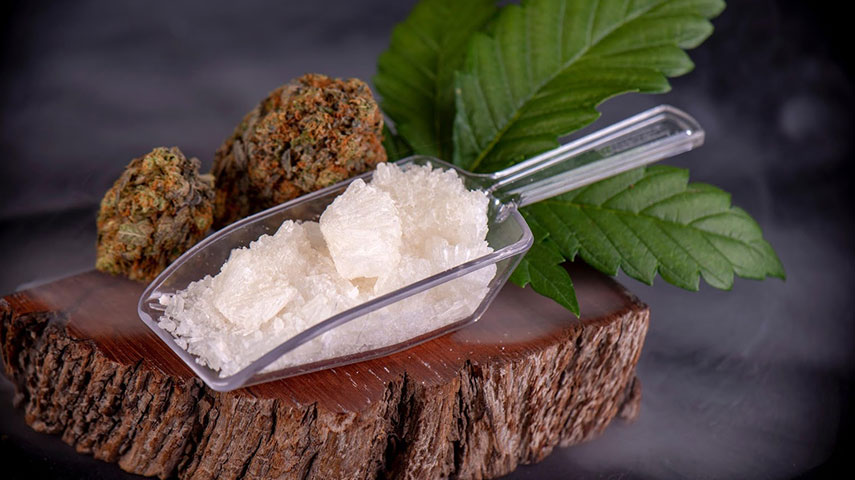
Hemp contains literally hundreds of different plant compounds (we’ll describe those more a little later). Premium hemp extracts, in turn, usually contain many of these compounds. CBD isolate is different.
CBD isolate is a distinct type of hemp extract that contains just CBD and none of hemp’s other active ingredients.
Unlike other hemp extracts, CBD isolate is not an oil. It’s a white, crystalline powder that’s 95%-99.9% CBD. There’s no THC, no trace cannabinoids, no terpenes, no oils . . . just CBD in its purest and most refined form.
CBD isolate is also tasteless and scentless, which makes it great for branding aesthetics. Even large amounts of isolate can be blended into a CBD oil with no sensory trace.
How Is CBD Isolate Made
CBD isolate is made through a multi-step extraction process. This process starts off virtually the same way that any hemp extraction does: with a chemical extraction involving ethanol, CO₂, or another polar solvent. These solvents are able to pull hemp’s fat-soluble active ingredients out of its biomass, creating a concentrated extract rich in CBDa, CBD’s raw form.
From there, though, the processes that create CBD’s different varieties begin to diverge. Some full spectrum extracts would be close to finalized at this point, but CBD isolate is just getting started!
The first extraction produced a ‘crude’ extract that still needs several types of refining. This extract is then put through a special process (usually fractional distillation) that separates out each cannabinoid according to its molecular weight. THCa is heavier than CBDa, which means it can be isolated and filtered out. Additional methods like centrifugal partition chromatography may also be used to separate CBDa from other cannabinoids and terpenes. Still other methods include winterization, polishing, and dewaxing. Along the way CBDa isolate will also need to be decarboxylated into CBD, its active form.
Believe it or not, these processes are actually simpler than they sound. And when they’re all said and done, the result is highly purified CBD isolate. Indeed, premium isolates may be as much as 99.9% pure.
At this level of purity the substance takes a crystalline form: totally scentless and flavorless. It’s also worth noting that CBD isolate is visually indistinguishable from THC isolate or the isolate form of any other cannabinoid.
The Drawbacks of CBD Isolate
As nice as the idea of a “pure” extract may seem, there are downsides to CBD isolate. Call it a Sampson complex: when CBD is separated from the other active ingredients in hemp, it loses much of its power. CBD itself is just one large, clumsy molecule, and though it means well, it has a low affinity for the body’s picky endocannabinoid receptors when on its own. CBD isolate misses out on the benefits of the entourage effect seen with full spectrum products. It also doesn’t manage to hit anywhere close to the 20+ molecular targets that full spectrum CBD does.
This isn’t all just theory, either. Those who take CBD isolate products instead of something
more complete may have to take four times as much of it! (More on this finding later)
Nonetheless, CBD isolate products are easy to find. The reason? Production cost is low, often very low, which means producers can easily keep their profit margins high. Speaking to Project CBD, a scientist who played a pivotal role in discovering the endocannabinoid system explained this conflict of interest well: “I can see two different directions [for the future of cannabis]. One will focus on [the] production of derivatives of active compounds that could be patented and sold in order to make as much money as possible . . .”
Thankfully, there’s a better way: letting nature do its thing:
“The other direction puts patients before profit and focuses on the use of the whole plant and synergistic effects of its compounds.”
While CBD isolate may be better than nothing, why settle? Especially when there are much better options out there. Let’s examine them by contrasting CBD isolate with what you might find in a full spectrum hemp product—beginning with what you’d find in mature hemp.
What Compounds Are in the Hemp Plant?
To put it simply . . . lots. These compounds can be placed into several different categories: there are cannabinoids, terpenes, flavones, chalcones, waxes, and more.
Cannabinoids:
In mature hemp, cannabinoids are usually featured in this order of concentration: CBDa, THCa, CBN, CBGa, CBCa, and then finally THCVa. Every phenotype (variety) of hemp is different, however. Also remember that hemp contains the raw forms of virtually every cannabinoid; standard forms don’t show up until hemp is ‘decarbed’ during the production process. All told there are over 100 cannabinoids in hemp, but only CBD and THC are found
in any significant amount.
-
- CBDa | Cannabidiolic Acid is a relaxing, calming cannabinoid that may reduce anxiety.
-
- THCa | Tetrahydrocannabinolic Acid is a stimulatory cannabinoid that produces mental and physical effects.
-
- CBN| Cannabinol is a deeply relaxing cannabinoid that induces calmness and sleep.
-
- CBCa | Cannabichromenic Acid is a stimulatory cannabinoid that may have anti- inflammatory effects.
-
- THCVa | Tetrahydrocannabivarinic Acid is a stimulatory cannabinoid that may calm inflammation and reduce seizures.
Terpenes:
There are over 300 terpenes that may be found in a single strain of hemp. Most are found in only trace quantities, but they still provide some synergy by contributing to the entourage effect.
-
- Myrcene | Relaxing, sedative, sleep aid
-
- Pinene | Relaxing, helpful for focus, bronchodilator
- Beta-Caryophyllene | Stimulating, helpful for focus, anti-inflammatory
-
- Eucalyptol | Stimulating, improves intestinal health, anti-inflammatory
-
- Terpinene | Relaxing, antibacterial, sleep aid
Flavones:
There are hundreds of flavonoids in nature, and these plant metabolites even have their own subgroup that’s found specifically in hemp: cannflavin A and cannflavin B. Cannflavins have very strong antioxidant properties that are still being studied.
Chalcones:
Chalcones are plant metabolites that demonstrate antibacterial properties. They’re good for hemp . . . and good for us! Chalcones are also used as precursors, or building blocks, in the formation of flavones and other plant compounds.
Alkaloids:
Alkaloids are found throughout nature. They’re a highly stimulating and diverse class of plant molecules. While alkaloids are an umbrella group, they include molecules found in hemp in trace amounts.
Plant Waxes:
A special kind of fatty acid, these lipids often contain some of the other plant compounds found in hemp. They may also be rich in omega 3, 6, and 9.
Chlorophylls:
Used in photosynthesis, chlorophylls are also found in the hemp plant and are useful for plants because they help gather energy from sunlight. And like alkaloids, they’re also useful to us because they foster mitochondrial health .
The Entourage Effect
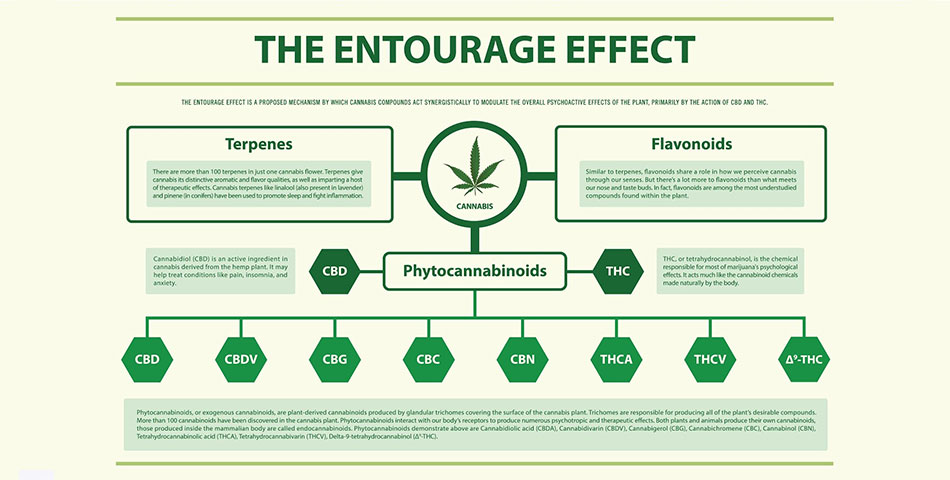
Together, hemp’s synergy of cannabinoids, terpenes, and other plant molecules causes a potentiated effect that is greater than the sum of its parts.
The health benefits of this comprehensive blend far exceed the effects of any one molecule in isolation. Think of it this way: would you rather consume broccoli or take vitamin C? Broccoli is the holistic choice, in that it contains much more than just one vitamin.
In the same way, the ideal hemp product will contain as diverse a blend of compounds as possible. Full spectrum CBD is much more effective, and holds truer to nature’s design, than anything else. Only full spectrum CBD harnesses hemp’s natural synergy. 1 + 1 + 1 + 1 may usually equal 4, but in this case, it equals 10.
Is Full Spectrum CBD Better than Isolate?
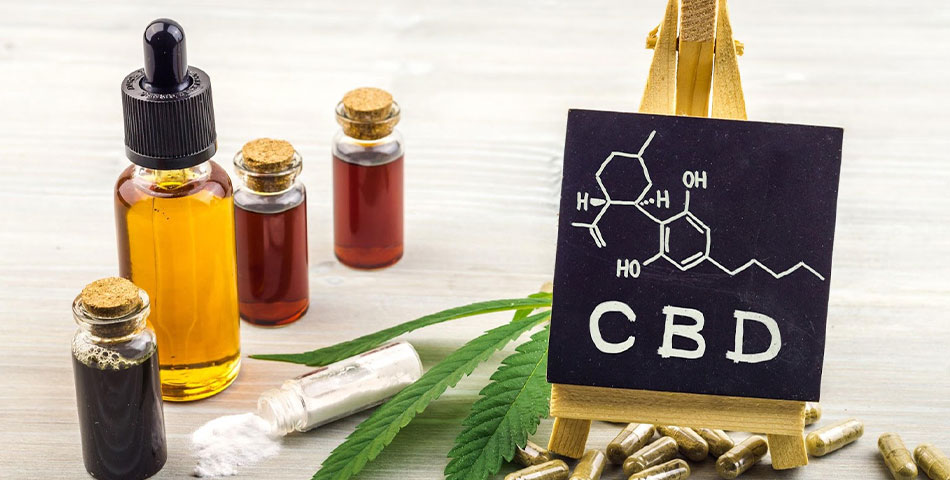
Based on all the available evidence, full spectrum is better than CBD isolate. Even then . . . there may be a few caveats. In the name of being objective, let’s take a quick look at them.
Those who wish to avoid THC entirely may prefer CBD isolate over other options. That’s because full spectrum CBD usually contains a trace amount of THC—not enough to be psychotropic, but a detectable amount nonetheless.
CBD Isolate vs. Clone 202 Extract
For many years, the isolate vs. whole plant extract debate was only anecdotal. But in 2017 that all changed. That’s when the University of Jerusalem came out with yet another insightful medicinal cannabis study.
This study’s premise? The fact that CBD isolate dosing can be pretty fickle. In past research, the researchers explained, “healing was only observed when CBD [isolate] was given within a very limited dose range, whereas no beneficial effect was achieved at either lower or higher doses. This trait of purified CBD imposes serious obstacles.”
The study’s authors theorized that a full spectrum CBD product called clone 202 extract would fare better, so they decided to test things out. They gave one group of lab mice purified CBD and the other group this special extract. Both inflammatory markers and pain levels were measured as mice were given different dosing of these different substances.
The findings affirmed what so many had known all along: that nature knows best. Mice given the full spectrum extract experienced less pain and tangibly lower levels of an inflammatory cytokine called TNF-alpha. Just as impressive, things only got better as more full spectrum CBD was administered. Even the mice who took extremely high doses of full spectrum CBD never reached a point of diminishing returns.
The study also showed that full spectrum CBD could be up to four times more effective, per milligram, than CBD isolate, which implies something interesting. Not only are CBD isolate products less health-effective . . . they’re also less cost-effective from the consumer’s perspective!
Given that CBD isolate misses out on the entourage effect, maybe we shouldn’t be so surprised. Cannabis expert Dr. Ethan Russo explained why in a breakthrough study of his own, noting that “one molecule is unlikely to match the therapeutic and even industrial potential of cannabis itself as a phytochemical factory.”
Nano Full Spectrum CBD
As effective as full spectrum CBD oil is . . . it can get even better.
The best CBD oils use a special type of nanotechnology to improve their absorption. Nanotechnology doesn’t actually change the size of CBD molecules themselves—it’s more subtle than that. What nanotechnology does is allow CBD molecules to form smaller groups and disperse more evenly throughout their environment. The result is a CBD oil with more surface area that can dissolve deeper into the nooks and crannies of one’s cells.
A special process called nano-emulsification makes nano CBD possible. This process happens post-extraction and entails placing CBD molecules within a cushion of fatty acids known as a liposome. The cells of our bodies are liposomes, too, so this process is about as natural as it gets.
When CBD goes nano, it takes on certain qualities it wouldn’t have otherwise. The most noticeable one? Nano CBD is water-soluble, unlike conventional CBD, so it can dissolve easily into water. Nano CBD also kicks in radically faster than other options. Finally, because its absorption rate is so high, nano CBD might actually be the cheapest way to get active cannabinoids into your bloodstream. Thanks to nanotechnology you can take fewer milligrams of CBD and still get great results.
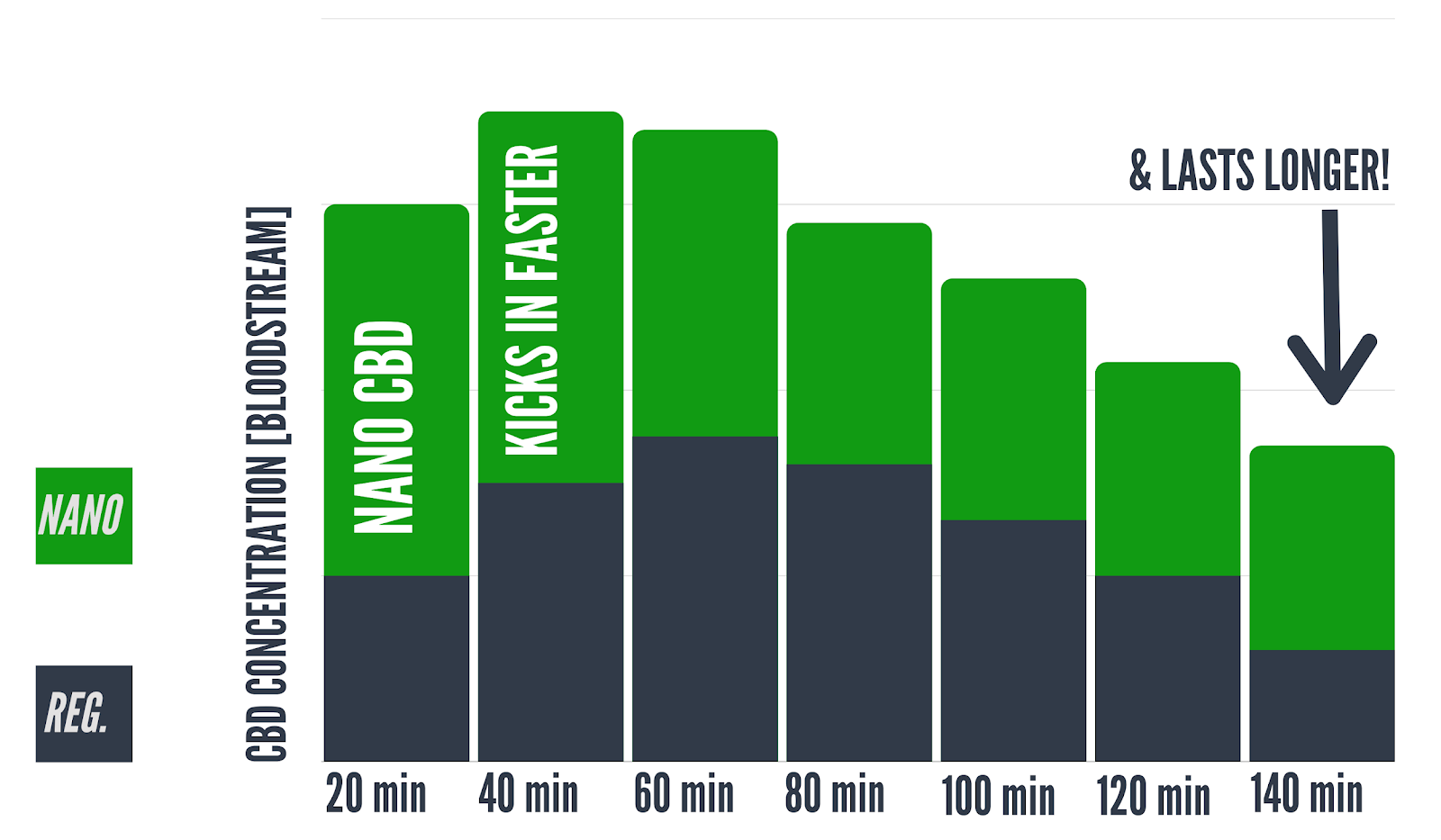
Water-soluble CBD: A Perfect Fit
Just think how much more convenient CBD dosing would be if you could infuse CBD into a favorite drink. Actually, don’t just think about it—nano CBD makes this ideal an actual possibility! Nano CBD is water-soluble almost by definition. You can blend it into a smoothie, infuse it into delicious bulletproof coffee, put it into a sports drink or protein shake, or even add some to your alcoholic beverage of choice (some research on CBD shows a potential liver-protecting effect). Long story short, the possibilities may not be endless . . . but they’re only limited by your imagination.
More research is still needed to uncover all the benefits of water-soluble CBD, and more experimentation may still be needed before you find your favorite CBD-infused beverage. But the initial verdict is clear: oil and water don’t mix, and neither do conventional CBD oil and your water-based body.
Research on Full Spectrum CBD
When CBD was discovered in 1940 it was described as a “relatively inactive component” of cannabis. Thankfully, our understanding has come a long way since then. Research has shown over and over that CBD is very active, both on the peripheral body and on the mind. And newer research (like the 2017 Israel study we mentioned above) has managed to take things even further, quantifying the impact of trace compounds on CBD’s power.
The thing is . . . that study is far from the only one to report such findings. Below are similar verdicts from several others:
A 2018 study published in Frontiers in Neurology found that full spectrum CBD was more effective than purified CBD for those with intractable epilepsy. (Sound familiar?) “Reports about improvement in ‘secondary’ health aspects” were also “very common” among study participants. Also note this was a clinical study involving 670 human patients, not ‘just’ an early study done on lab mice. Study authors concluded with confidence: “it’s clear that CBD works for this type of epilepsy, with over 60% of volunteers describing clinical improvement.”
A more theoretical—but equally insightful—study looked at CBD and THC’s effects on neuropathic pain. We’ll spare you the technicalities of this one, because its conclusion was clear: “very low ineffective doses of CBD and THC were synergistic [i.e., effective] when given in combination.”
Dr. Ethan Russo has always been ahead of his time, and in a 2006 review he distilled all the available literature to reach a poignant conclusion. “The hypothesis that the combination of THC and CBD increases clinical efficacy while reducing adverse events is supported.”
Wrapping Things Up . . .
On second thought, perhaps Dr. Roger Loewe’s “relatively inactive” verdict about CBD was partially right. But only if you’re talking about an isolated CBD extract instead of full spectrum CBD.
To Your Health
Green Maiden

